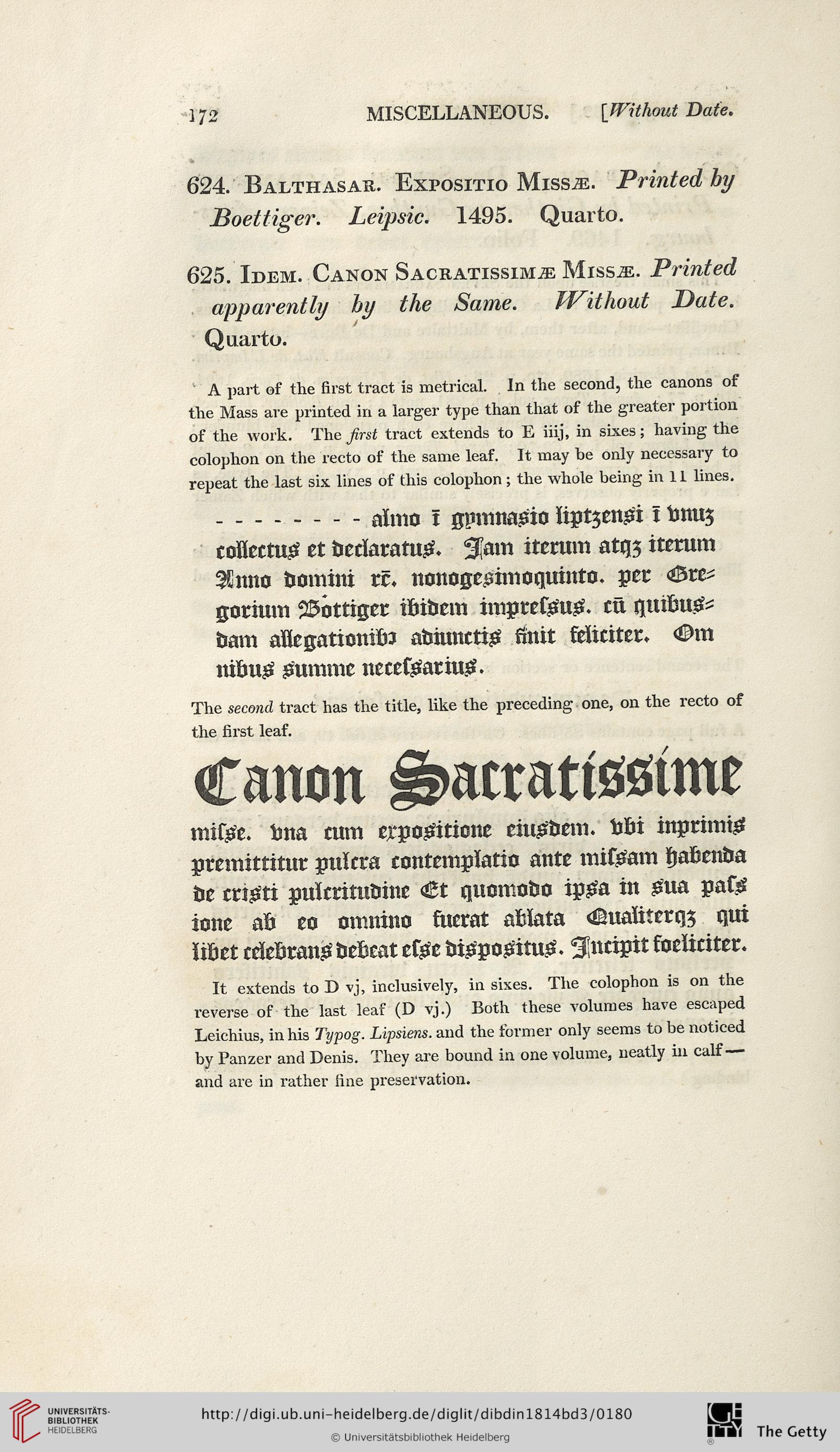172
MISCELLANEOUS. \Without Date.
624. Balthasar. Expositio Miss^e. Printed hy
Boettiger. Leipsic. 1495. Quarto.
625. Idem. Canon Sacratissim^e Missje. Printed
apparently hy the Same. Without JDate.
Quarto.
A part of the first tract is metrical. In the second, the canons of
the Mass are printed in a larger type than that of the greater portion
of the work. The first tract extends to E iiij, in sixes; having the
colophon on the recto of the sanie leaf. It may be only necessary to
repeat the last six lines of this colophon; the whole being in 11 lines.
..nlnio t gpninnsio lipt$cn£i t tmu$
co$cctu£ ct ticdnrntu.o. 3sam itcrum ntq$ itcrurn
31nno tiomim rc. nonogcmmoquinto. pcr <*3rc^
gorium 53ottigcr ifiiticm imprcfetUT. cu rjuifms^
trnrn nsscgntionifo ntiiunctio sinit fdicitcr. <&\n
nitm.o oummc ncccsgnriug.
The second tract has the title, like the preceding one, on the recto os
the first leaf.
Canon ^acrattsstnte
mispc. bnn cum crpooiticnc ciupticm. Pfii inprimt^
prcmittitur pulcrn contcmpktio nntc misonm ijnftcntin
tic cn^ti puicrituOinc €t quomotio ip£n in 0un pns£
ionc nfi co omnino fuernt afilnta <®untttcrq$ tjui
lifict cricBrnnp ticEcat csoc tii.itpo.oitu.o. S ncipit foclicitcr.
It extends to D vj, inclusively, in sixes. Tlie colophon is on the
reverse of the last leaf (D vj.) Both these volumes have escaped
Leichius, in his Typog. Lipsiens. and the former only seems to be noticed
by Panzer and Denis. They are bound in one volume, neatly in calf—
and are in rather fine presei'vation.
MISCELLANEOUS. \Without Date.
624. Balthasar. Expositio Miss^e. Printed hy
Boettiger. Leipsic. 1495. Quarto.
625. Idem. Canon Sacratissim^e Missje. Printed
apparently hy the Same. Without JDate.
Quarto.
A part of the first tract is metrical. In the second, the canons of
the Mass are printed in a larger type than that of the greater portion
of the work. The first tract extends to E iiij, in sixes; having the
colophon on the recto of the sanie leaf. It may be only necessary to
repeat the last six lines of this colophon; the whole being in 11 lines.
..nlnio t gpninnsio lipt$cn£i t tmu$
co$cctu£ ct ticdnrntu.o. 3sam itcrum ntq$ itcrurn
31nno tiomim rc. nonogcmmoquinto. pcr <*3rc^
gorium 53ottigcr ifiiticm imprcfetUT. cu rjuifms^
trnrn nsscgntionifo ntiiunctio sinit fdicitcr. <&\n
nitm.o oummc ncccsgnriug.
The second tract has the title, like the preceding one, on the recto os
the first leaf.
Canon ^acrattsstnte
mispc. bnn cum crpooiticnc ciupticm. Pfii inprimt^
prcmittitur pulcrn contcmpktio nntc misonm ijnftcntin
tic cn^ti puicrituOinc €t quomotio ip£n in 0un pns£
ionc nfi co omnino fuernt afilnta <®untttcrq$ tjui
lifict cricBrnnp ticEcat csoc tii.itpo.oitu.o. S ncipit foclicitcr.
It extends to D vj, inclusively, in sixes. Tlie colophon is on the
reverse of the last leaf (D vj.) Both these volumes have escaped
Leichius, in his Typog. Lipsiens. and the former only seems to be noticed
by Panzer and Denis. They are bound in one volume, neatly in calf—
and are in rather fine presei'vation.




